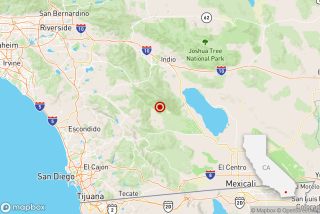Scientists develop new app that uses your cellphone to detect earthquakes
When the earth shakes in California, the first place you are likely to hear about it is on social media.
“Earthquake!” “Did you feel that?” “How big?” are common messages on Twitter and Facebook as Californians try to share information on their mobile phones in real time.
Now, UC Berkeley scientists are hoping to capture that sharing impulse in a massive science experiment: Using cellphones to detect earthquakes as soon as they start. They hope that by turning mobile phones into vast data collection points, they can quickly glean information about the quakes and warn those farther away from the epicenter that shaking is on the way.
See more of our top stories on Facebook >>
On Friday, scientists unveiled an app that will test this idea with anyone around the world who wants to participate. Named MyShake, the free app, available on Google Android phones and at myshake.berkeley.edu, uses smartphone sensors to detect movement caused by an earthquake.
Users who download the app will be sending data to scientists when an earthquake as small as a magnitude 5 hits.
By harvesting information from hundreds of phones closest to the earthquake, scientists will be able to test a computer system that could, in the future, dispatch early warnings that shaking is seconds or minutes away to people farther away from the earthquake’s origin. For instance, if a quake started in San Bernardino, cell phones there could register the quake and quickly help send warnings to smartphone users in Los Angeles.
“This is a citizen science project,” said Richard Allen, director of the Berkeley Seismological Laboratory at UC Berkeley. “This is an app that provides information, education, motivation — to the people who’ve downloaded it — to get ready for earthquakes. Those same people are contributing to our further understanding of earthquakes, because they’re collecting data that will help us better understand the earthquake process.”

Richard Allen, director of UC Berkeley’s Seismology Laboratory, demonstrates how the MyShake app collects data and discusses the importance of this crowdsourced seismological network. (Roxanne Makasdjian and Stephen McNally / UC Berkeley)
The app uses a common sensor found in smartphones, called accelerometers, that determine if the phone is being used vertically or horizontally. For instance, it makes the phone capable of being a steering wheel in a racing game. Fitness trackers, such as pedometer apps, also use these sensors.
The app’s algorithm is designed to ignore ordinary shaking, like a phone jiggling in a purse, and detect unique vibrations felt during earthquakes. If the phone detects what it thinks is an earthquake — usually something at a magnitude 5 or greater — it sends a message to a central server.
If there are at least 300 phones sending warnings in the same 60-mile-by-60-mile zone, simulation tests show that’s good enough to tell the system that the shaking was an earthquake, Allen said.
Allen is also part of a larger team of scientists building a $38-million system along the West Coast that will provide early warnings before the worst shaking from an earthquake arrives. The U.S. Geological Survey’s ShakeAlert prototype has had successful tests — one gave researchers in San Francisco eight seconds of warning before the shaking from a magnitude 6.0 earthquake from Napa arrived.
The warnings will eventually give trains time to slow down, decreasing a risk of derailment before shaking arrives, sound an alert in hospitals to warn surgeons to halt surgery, and have elevators open their doors at the nearest floor, preventing people from becoming trapped.
A rollout of the early warning system to the public has been stymied by a lack of full funding. Only about half of the annual $16-million operating cost has been paid for by the federal government. So far, West Coast states have yet to pledge contributions for the system’s operating costs, but several lawmakers in Sacramento proposed this week that California help fund completion of the system.
The cellphone MyShake app would not replace the USGS’ early warning system, Allen said. Smartphones will never be as effective as hundreds of sophisticated earthquake sensor stations installed underground to detect the first subtle signs that an earthquake has begun.
Still, a successful smartphone app, woven into the USGS system, could make the overall warning network even faster in California, Oregon and Washington state, he said. And it would enable the technology to be used in other areas of the world with few or no earthquake sensors.
“Nepal has almost no seismic stations. But they have 6 million smartphones. There are 600,000 smartphones in Kathmandu alone,” Allen said. “So if we can get MyShake working, then we could potentially be providing early warning in Kathmandu.”
The app was released by the Berkeley Seismological Laboratory and developers with Deutsche Telekom Silicon Valley Innovation Laboratories of Mountain View, Calif. Allen said the team will consider creating an iPhone version of the app if many people download the Android version.
The announcement of the app’s release was made in the journal Science Advances, and is being presented at the annual meeting of the American Assn. for the Advancement of Science in Washington.
Scientists not involved with the app say it is a welcome development for early warnings in the United States, and represents a great use of “crowdsourcing” — using information gathered by the public — for science.
There are already indications that the approach is valuable to scientists. Twitter, for instance, is so fast that people tweeting about an earthquake can outpace the official seismic detection network in parts of the world with very few sensor stations, said USGS research geophysicist Sarah Minson.
Minson has been using similar smartphone technology to bring a less costly early warning system to Chile. She is working with a team to install about 200 smartphones -- programmed with a GPS sensor-based quake-detection app -- in boxes and placing them on roofs to act as seismic sensor stations.
“Smartphones are fantastic. And they’re cheap, and they’re ubiquitous,” Minson said. The sheer number of smartphone users around the world gets “us so much more data than we can get just from scientific instruments. Scientific instruments are obviously much higher quality, but we are limited in terms of numbers by their expense.”
Allen said the new Android app runs silently in the background, and sends a tiny amount of data as the earthquake is happening. Five minutes’ worth of shaking data, for research purposes, is transmitted later, when the phone is charging and is connected to Wi-Fi.
There are benefits to having the cellphone app and the traditional, ground-based sensor system working together, Allen said.
The ground system is so sensitive it can detect even the lightest preliminary shaking waves that may not be felt by humans. They’re called P waves, and the USGS system currently requires at least four ground stations to go off to trigger an alert.
Cellphones are more likely to detect the second, slower set of earthquake waves that arrive — S waves, the kind that bring severe destruction and brings the shaking that humans feel.
See the most-read stories this hour >>
In the future, Allen envisions a more integrated network that might only require one or two ground sensors to detect an earthquake, and confirmation from cellphones to trigger an alert faster than the current system of relying on four traditional sensors.
Crowdsourcing data from citizen scientists are part of a growing trend in many fields of research.
Consider the labor-intensive task of monitoring a stream’s levels. “If you only have scientists doing that, that limits how much data you get in,” Minson said. “But if you just put a sign next to your stream gauge saying, ‘Please text me what the stream gauge says,’ you get a lot more measurements without having to pay for telemetry.”
Minson said she’s excited to see how the public will respond to Friday’s new earthquake app.
“There’s something about the smartphone idea that makes it just so much more personal to people,” she said.
rosanna.xia@latimes.com
Twitter: @RosannaXia
ron.lin@latimes.com
Twitter: @ronlin
ALSO
Lawsuit contends the California bullet train project is violating state law
‘Bay Boys’ surfer gang cannot block access to upscale beach, Coastal Commission says
Volcanic spires and Joshua trees: Obama protects 1.8 million acres in California’s desert
More to Read
Start your day right
Sign up for Essential California for news, features and recommendations from the L.A. Times and beyond in your inbox six days a week.
You may occasionally receive promotional content from the Los Angeles Times.








